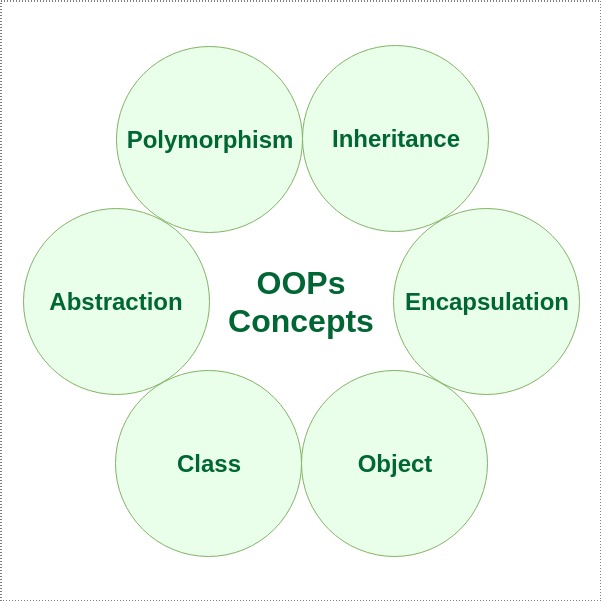13.1: Object Oriented Programming
- Page ID
- 29112
Object Oriented Programming in C++
Object-oriented programming – As the name suggests uses objects in programming. Object-oriented programming aims to implement real-world entities like inheritance, hiding, polymorphism, etc in programming. The main aim of OOP is to bind together the data and the functions that operate on them so that no other part of the code can access this data except that function.
Characteristics of an Object Oriented Programming language

We will discuss each of these concepts in greater detail in the following modules. For now, here are some very brief descriptions of each of the concepts shown in the above image.
Class: The building block of C++ that leads to Object-Oriented programming is a Class. It is a user-defined data type, which holds its own data members and member functions, which can be accessed and used by creating an instance of that class. A class is like a blueprint for an object.
Object: An Object is an identifiable entity with some characteristics and behavior. An Object is an instance of a Class. When a class is defined, no memory is allocated but when it is instantiated (i.e. an object is created) memory is allocated.
Object take up space in memory and have an associated address like a record in pascal or structure or union in C.
When a program is executed the objects interact by sending messages to one another.
Each object contains data and code to manipulate the data. Objects can interact without having to know details of each other’s data or code, it is sufficient to know the type of message accepted and type of response returned by the objects.
Encapsulation: In normal terms, Encapsulation is defined as wrapping up of data and information under a single unit. In Object-Oriented Programming, Encapsulation is defined as binding together the data and the functions that manipulate them.
Consider a real-life example of encapsulation, in a company, there are different sections like the accounts section, finance section, sales section etc. The finance section handles all the financial transactions and keeps records of all the data related to finance. Similarly, the sales section handles all the sales-related activities and keeps records of all the sales. Now there may arise a situation when for some reason an official from the finance section needs all the data about sales in a particular month. In this case, he is not allowed to directly access the data of the sales section. He will first have to contact some other officer in the sales section and then request him to give the particular data. This is what encapsulation is. Here the data of the sales section and the employees that can manipulate them are wrapped under a single name “sales section”.
Abstraction: Data abstraction is one of the most essential and important features of object-oriented programming in C++. Abstraction means displaying only essential information and hiding the details. Data abstraction refers to providing only essential information about the data to the outside world, hiding the background details or implementation.
Consider a real-life example of a man driving a car. The man only knows that pressing the accelerators will increase the speed of the car or applying brakes will stop the car but he does not know about how on pressing accelerator the speed is actually increasing, he does not know about the inner mechanism of the car or the implementation of accelerator, brakes etc in the car. This is what abstraction is.
Polymorphism: The word polymorphism means having many forms. In simple words, we can define polymorphism as the ability of a message to be displayed in more than one form.
A person at the same time can have different characteristic. Like a man at the same time is a father, a husband, an employee. So the same person posses different behaviour in different situations. This is called polymorphism.
An operation may exhibit different behaviours in different instances. The behaviour depends upon the types of data used in the operation.
Inheritance: The capability of a class to derive properties and characteristics from another class is called Inheritance. Inheritance is one of the most important features of Object-Oriented Programming.
- Sub Class: The class that inherits properties from another class is called Sub class or Derived Class.
- Super Class:The class whose properties are inherited by sub class is called Base Class or Super class.
- Reusability: Inheritance supports the concept of “reusability”, i.e. when we want to create a new class and there is already a class that includes some of the code that we want, we can derive our new class from the existing class. By doing this, we are reusing the fields and methods of the existing class.
Adapted from: "Object Oriented Programming in C++" by Vankayala Karunakar, Geeks for Geeks


